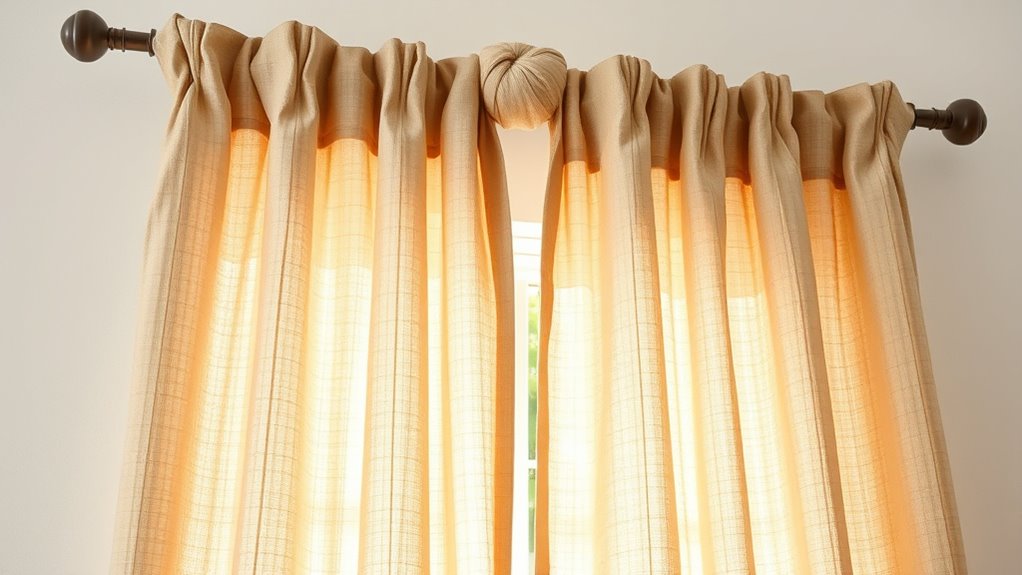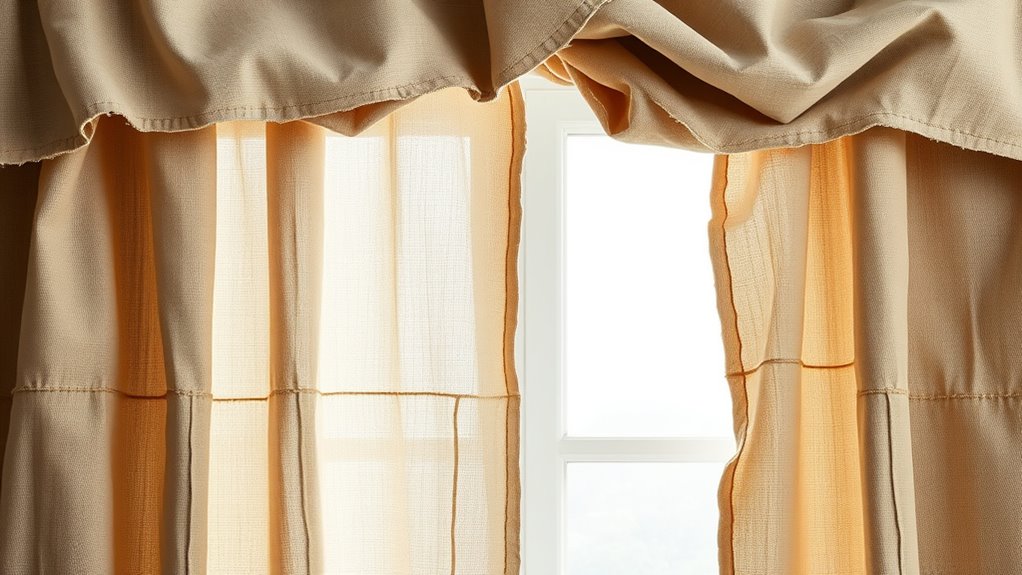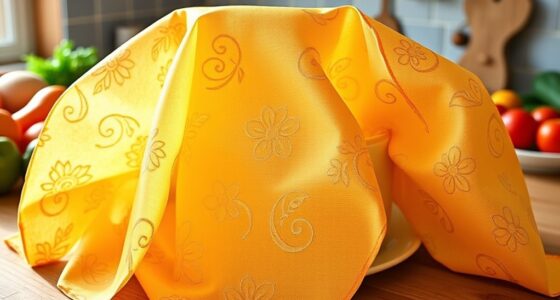To create drop-cloth curtains with a no-sew hack, start by measuring your window and cutting the fabric to size, adding extra inches for hems. Fold the edges and secure them with double-sided tape or fabric glue for a clean finish. Attach rings or tabs for easy hanging and customize with paint, stencils, or tie-backs to fit your style. If you want more tips and ideas, keep going to see how to make your curtains truly stand out.
Key Takeaways
- Measure your window and cut the drop cloth with straight edges, adding extra inches for hems and gathering.
- Fold and secure hems using fabric glue or double-sided tape for a clean, no-sew finish.
- Attach hardware like rings or tabs directly to the fabric’s top or hem for easy hanging without sewing.
- Personalize with paint, stencils, or tie-backs to match your decor style without sewing tools.
- Use sturdy hardware and layered dyeing or painting techniques to add visual interest and a custom look.
Gathering Your Supplies and Preparing the Drop Cloth

Before you start creating your no-sew drop-cloth curtains, gather all the necessary supplies. First, choose your fabric pattern—drop cloths come in various textures and designs, so pick one that suits your style. Make sure you have enough fabric to fit your window comfortably. Next, select the appropriate curtain hardware, such as rods and hooks, that will hold your curtains securely and complement your decor. You’ll also need basic tools like scissors, a measuring tape, and possibly fabric glue or adhesive strips if needed. Check the drop cloth for any wrinkles or stains and wash or iron it if necessary. Having everything ready before you begin will make the process smoother and guarantee your finished curtains look polished and professional. Additionally, consider cybersecurity best practices to protect your online information while shopping for supplies or sharing your project online.
Measuring and Cutting the Fabric to Fit Your Window

To guarantee your drop cloth curtains fit perfectly, start by measuring your window’s dimensions carefully. Use a tape measure to determine the width and length, adding a few extra inches for hems and gathering. Consider your fabric patterns—if you want the pattern to align symmetrically, plan your cuts accordingly. Think about your curtain rod type: if you have a rod with rings or clips, leave enough space at the top for easy hanging. Mark your measurements clearly on the fabric before cutting with sharp scissors. Keep your cuts straight to ensure a clean look. By taking precise measurements and considering fabric patterns and curtain rod types, you’ll create custom-fit curtains that look professional and stylish. Additionally, understanding the importance of proper fabric selection can enhance the overall appearance and durability of your curtains.
Creating a No-Sew Hem With Double-Sided Tape or Fabric Glue

Creating a no-sew hem with double-sided tape or fabric glue is an easy way to finish your curtains without sewing. Start by folding the fabric edge to your desired hem length, then press it flat. Apply double-sided tape along the fold or use fabric glue for a secure hold. Make sure to smooth out any wrinkles or bubbles for a clean finish. If your fabric has patterns, align them carefully before pressing the hem to maintain a consistent look. Once the adhesive sets, you can attach curtain hardware like rods or hooks directly to the top or sides, depending on your style. This method keeps your curtains looking neat and professional without the need for a sewing machine. It’s a quick, affordable solution that works with various fabric patterns and curtain hardware options. Incorporating positive thinking strategies can also help you approach DIY projects with confidence and patience.
Adding Tabs or Rings for Easy Hanging

To hang your drop cloth curtains easily, you’ll want to choose durable materials like metal or sturdy plastic rings and tabs. Make sure you attach the tabs securely to prevent them from tearing or slipping over time. With strong, well-placed hardware, your curtains will stay in place and look great. Incorporating best beaches features like scenic views and charming shops can even inspire your decorative choices for a beach-inspired look.
Choosing Durable Materials
Choosing durable materials for your drop-cloth curtains can make a big difference in their longevity and ease of use. When selecting fabric, prioritize material selection that offers high fabric durability to withstand daily wear and tear. Heavy-duty canvas or thick polyester blends are excellent options, as they resist tearing and fading. Avoid lightweight or flimsy fabrics that may sag or rip quickly. Consider the weight of the material—heavier fabrics tend to hang better and last longer. Opting for sturdy materials not only ensures your curtains stay intact but also makes it easier to add features like tabs or rings later on. Additionally, selecting fabrics with moisture resistance can help prevent mold or mildew in humid environments. Remember, investing in quality material now saves you time and money on repairs or replacements down the road.
Attaching Tabs Securely
Attaching tabs or rings securely is essential to guarantee your drop-cloth curtains hang smoothly and stay in place. Choose curtain hardware that complements your fabric patterns for a cohesive look. Use sturdy clips or grommets to attach the tabs, ensuring they hold weight evenly. For added security, reinforce the fabric with extra stitches or adhesive strips. Consider the weight of your fabric and the type of curtain hardware to prevent slipping or tearing. Here’s a quick guide:
| Fabric Pattern | Suitable Curtain Hardware |
|---|---|
| Bold stripes | Heavy-duty grommets |
| Subtle prints | D-Rings or clip rings |
| Solid colors | Simple hooks or tabs |
Proper hardware selection can also help maintain the color accuracy of your curtains, especially if you want them to match or complement your room’s decor. This ensures your curtain setup is both functional and visually appealing.
Hanging and Adjusting Your New Curtains

Once you’ve gathered your materials and decided on the placement, hanging your new curtains is straightforward. Start by installing the appropriate hanging hardware, ensuring it’s securely anchored into the wall. When selecting your curtain rod, choose one that complements your curtains and fits your space; a sturdy rod will support the weight of the fabric. To hang your curtains:
Hanging curtains is simple: install hardware securely, choose a sturdy rod, and adjust for the perfect fit.
- Slide the drop-cloth over the curtain rod, making sure it’s centered.
- Adjust the length by raising or lowering the rod, depending on your desired curtain length.
- Secure the rod brackets tightly into the wall, double-checking for levelness.
- Consider the overall farmhouse bedroom design to ensure your curtains enhance the rustic charm and cozy ambiance.
With these steps, your curtains will hang smoothly and look polished. Proper hanging hardware and curtain rod selection are key to achieving a clean, professional appearance.
Tips for Customizing and Styling Your Drop-Cloth Curtains

You can personalize your drop-cloth curtains with creative painting techniques or stencils to add a pop of color and style. Experimenting with different tie-back ideas, like knots, ribbons, or hooks, instantly transforms their look. These simple tips help you craft a unique, tailored window treatment that reflects your personality. Incorporating sustainable materials into your DIY projects further supports eco-friendly living.
Creative Painting Techniques
Creative painting techniques can transform plain drop-cloth curtains into stunning focal points in your space. Using fabric dyeing, you can create vibrant, custom colors that match your decor perfectly. Stencil art allows you to add intricate patterns or designs effortlessly, giving your curtains a personalized touch. Here are some ideas to get you started:
- Use fabric dyeing to achieve a gradient or marbled effect, adding depth and interest.
- Incorporate stencil art with bold or subtle patterns to enhance visual appeal.
- Combine both techniques for a layered look that’s truly unique.
These methods are simple yet impactful, helping you craft curtains that reflect your style while avoiding the need for sewing or complex tools.
Unique Tie-Back Ideas
Adding personalized tie-backs is a simple way to elevate the look of your drop-cloth curtains. You can get creative by choosing fabric patterns that complement your decor, like bold prints or textured textiles. For a polished finish, explore unique curtain hardware options such as decorative hooks, vintage knobs, or sleek metal rings. These details can turn a basic tie-back into a statement piece. You might also consider repurposing items like braided ropes, leather strips, or even colorful scarves for a DIY touch. Experimenting with different fabrics and hardware allows you to customize your curtains to match your style, whether it’s modern, rustic, or eclectic. Additionally, understanding asset division laws can help ensure your home decor investments are protected during legal proceedings, giving you peace of mind. The key is to keep it functional while adding a personal flair that makes your window treatments stand out.
Frequently Asked Questions
Can I Use Drop Cloth Curtains Outdoors?
You can use drop cloth curtains outdoors, but consider outdoor durability first. Look for heavy-duty, tightly woven fabric options that resist weather elements like rain and sun. Regular drop cloths are often made of cotton or canvas, which may not hold up well outside without treatment. To guarantee longevity, opt for water-resistant or treated fabrics, and consider adding weatherproofing sprays. Proper installation and maintenance will help your outdoor curtains last longer.
What Is the Best Type of Drop Cloth for Curtains?
When choosing the best drop cloth for curtains, consider fabric durability and color options. Look for heavyweight canvas or cotton blends, as they’re sturdy and last longer. These fabrics resist tearing and wear, making them ideal for curtains that get frequent use. Also, pick a color that matches your decor, and opt for neutral shades or darker hues for better concealment and style. This way, your curtains stay functional and stylish over time.
How Do I Prevent the Fabric From Fraying?
Think of your fabric as a delicate dance partner that needs protection. To prevent fraying, you should apply a fraying prevention method like fabric sealant or hem the edges carefully. Using fabric glue or double-folded hems enhances fabric durability, ensuring your curtains stay intact over time. These simple steps act as a sturdy barrier, keeping your drop cloth curtains looking fresh and polished while extending their lifespan.
Are There Alternatives to Double-Sided Tape?
If you’re looking for alternatives to double-sided tape for fabric reinforcement, you have several options. Fabric glue or fusible webbing work well for securing edges without sewing. You could also try spray adhesive designed for fabrics or iron-on hem tape for a strong, no-sew hold. These alternatives provide reliable adhesion, prevent fraying, and are easy to apply, making your project simpler and more secure without needing tape.
Can I Wash or Clean the Drop Cloth Curtains?
Imagine you’re in a vintage speakeasy—your drop cloth curtains add charm, but can you clean them? Yes, you can! Use gentle cleaning tips like spot cleaning with mild soap and water for stains. For a full wash, check if they’re machine washable or hand wash. Avoid harsh chemicals to prevent damage. Always air dry to keep the fabric in tip-top shape, and remember, patience is key for stain removal.
Conclusion
With just a few simple steps, you’ve transformed a plain drop cloth into stylish curtains—like turning a blank canvas into a work of art. This no-sew hack proves that creativity can turn everyday materials into something beautiful and functional. So, go ahead, hang your new curtains with confidence, and enjoy the fresh, customized look you’ve crafted yourself. After all, your space is a reflection of your ingenuity—ready to inspire and impress.









